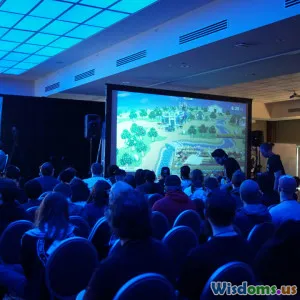
How Environmental Storytelling is Changing Single Player Experiences
18 min read Explore how environmental storytelling redefines single player games, deepening immersion and narrative through world design. (0 Reviews)
How Environmental Storytelling is Changing Single Player Experiences
Step into any modern single-player masterpiece and you’re likely to find yourself asking, “What happened here?” Environmental storytelling—where the world itself becomes a narrator—has transformed gaming, enabling players to experience narratives in more immersive, emotionally resonant ways. This storytelling approach moves beyond dialogue and cutscenes, embedding stories in architecture, decor, soundscapes, and hidden details. Let’s dive into how this subtle yet powerful technique is reinventing single-player adventures, engaging us not just as witnesses but as active interpreters of digital worlds.
The Essence of Environmental Storytelling

Instead of presenting a straightforward story, environmental storytelling weaves tales into the very fabric of a game’s surroundings. This allows for a hybrid narrative experience—players discover, interpret, and often fill in blank spaces themselves.
The principle is simple: actions, scenery, and leftover bits of life tell a story equal to any script. The burnt-out remains of a campfire, the cryptic blood trails on a tiled floor, or a child's stuffed toy in an abandoned hospital reveal far more than a monologue ever could.
Key Aspects
- Contextual Nuance: Players absorb subtle narrative details through visual cues and interactive elements.
- Nonlinear Discovery: Players often uncover story elements out of sequence, piecing together events for themselves.
- Player Agency: By letting players interpret what they see, a sense of ownership over the narrative emerges.
Games like Gone Home served as a watershed moment. Exploring the family home, players piece together emotional revelations not through voiceover, but through familiar artifacts left behind—a torn note, a locker sticker, or a locked cabinet. Every room becomes a chapter of the unfolding drama, empowering players to become detectives in their stories.
Iconic Examples in Modern Games

Some of the most memorable game moments rely heavily on environmental cues. Consider The Last of Us. The decaying American landscape is less post-apocalyptic set dressing, more tapestry of lost hopes and tiny triumphs. Each ruined shop and detail-laden home brims with stories waiting for attentive eyes—a child’s drawing on a refrigerator, or a message to nowhere scribbled on a wall.
Likewise, FromSoftware’s Dark Souls series is legendary for minimalist storytelling. Instead of spoonfeeding lore, the games scatter their world with dilapidated ruins, cryptic item descriptions, and enigmatic NPC placements. Connoisseurs piece together centuries of backstory from crypts' architecture, the positioning of corpses, and fragments of worn banners. Players who pay attention receive a dramatically deeper, richer understanding than those who only push forward.
Other standout examples include:
- Bioshock: Rapture’s art deco decay speaks of idealism corrupted. Audio logs and shadowed recreations paint scenes of the city's rise and fall.
- Hollow Knight: The hallows and ruins of Hallownest sing of forgotten histories, leaving it up to the player to infer the world's fate from its derelict grandeur.
This approach lingers far longer in a player’s memory, persisting because the act of piecing together a narrative is, inherently, interactive and rewarding.
Design Principles: Building Worlds with Stories

How can developers integrate environmental storytelling effectively? It’s a delicate art, merging gameplay, visuals, and world-building into one harmonious whole. Here’s a breakdown of effective techniques.
1. Details with Intent
Every cloth hanging on a line or graffiti scrawled across an alleyway should serve a purpose. In Red Dead Redemption 2, for example, even simple back alley interactions and the arrangement of homestead interiors serve as windows into character life and the society’s slow collapse under technological and social change.
2. Dynamic Interactions
Creating environments that react and change boosts immersion, just as in Prey (2017), where the Talos I space station is a living environment. Locked offices hint at dramas and disasters, and clues litter each area. Desks with spilled coffee and late-night emails unravel personal tales of the crew, while their fates hang like ghosts over the ruins.
3. Accessibility and Density
Environments must balance density of details without overwhelming players. Cluttering every corner risks confusion and narrative fatigue, while sparseness deadens curiosity. Games like Firewatch focus on a few meaningful environmental cues—like carefully chosen notes, radio effects, and changes in landscape in response to player choices.
Emotional Resonance and Immersive Empathy

Nothing forges a stronger connection between player and world than discovering another’s loss, love, or triumph by yourself. When players recognize narrative threads expressed through setting, the impact is profoundly personal—no scripted cinematic can replicate the feelings stirred by a hand-painted family portrait in a desolate home, or finding flowers reverently placed at a gravesite hidden in the woods.
In What Remains of Edith Finch, exploration is seamless with emotion. Each family member’s bedroom is crafted to reflect their personality, their secrets apparent not in files but textures, toys, and the arrangement of keepsakes. These unspoken tales heighten feelings of authenticity and loss as players piece together familial tragedy room by room.
Data supports this impact. According to a 2021 survey by the International Game Developers Association, over 60% of gamers reported a heightened sense of immersion when stories were told “through the world” as opposed to only via dialogue or cinematics.
How-to: Craft Environmental Stories as a Developer

Want to master this storytelling art in your game design? Here’s a practical, actionable checklist inspired by leading titles and developer insight:
-
Establish World Logic
- Define social, historical, and economic factors to guide artifacts, architecture, and decor. Create a living world consistent in its details—a post-apocalyptic world has dated modes of technology, feverishly repurposed.
-
Anchor Story to Spaces
- Assign emotional value to areas—was this a beloved child’s room? A site of tragedy? Let object placement, lighting, and damage tell the story. Use environmental changes to reflect player progress (ruined city after a battle, declining weather, growing plant life, etc.).
-
Theme and Mood
- Lighting, color, ambient sounds, and even weather all contribute. Will you use cold, sterile hues for a sense of death, or warm, scattered sunlight to hint at hope?
-
Encourage Exploration Beyond the Main Quest
- Reward the curious—hidden alcoves, notes, or environmental puzzles. In Control, many secret vignettes reward observation rather than brute force.
-
Iterative Playtesting
- Invite early testing to gauge if clues are inferred as intended. Overly obscure cues risk confusion, while over-informing can flatten the mystery.
The iterative process is the developer’s best friend here; it ensures stories in the world support rather than distract from overall player engagement.
Environmental Storytelling and Accessibility

While visually-rich games enthrall observational players, accessibility remains a hurdle. How can game narratives reach the widest possible audience?
- Audio Cues: Subtle music, environmental sounds, and narrated clues help visually impaired players access hidden stories.
- Tactile Feedback: For platforms supporting haptics—the rumble of an approaching storm or trembling when near danger provide more than visual indicators.
- Customizable Visual Aids: The Last of Us Part II pioneered robust accessibility, offering high-contrast display modes, descriptive sound cues, and contextual dialogue reductions.
Inclusive design means all players can interpret and value the narrative threads spun across virtual landscapes—an essential consideration for the future of gaming as a global, universal medium.
Environmental Storytelling versus Traditional Narrative

While environmental storytelling excels in many areas, how does it compare to traditional, linear forms?
| Aspect | Traditional Narrative | Environmental Storytelling |
|---|---|---|
| Delivery | Dialogue, cutscenes, scripted events | World details, props, player agency |
| Player Agency | More passive | Highly active |
| Narrative Flexibility | Linear | Nonlinear, player-driven |
| Replay Value | Moderate | High (can miss/discover new details) |
| Emotional Impact | Direct | Emergent, personal |
Environmental storytelling doesn’t seek to replace linear tales—it augments them. Games like Half-Life 2, for instance, blend memorable character dialogue with world-embedded clues, leveraging the strengths of both—and resulting in an enduring classic.
When Environmental Storytelling Fails: Pitfalls to Avoid

Of course, not every attempt hits its mark. Sometimes worlds groan under the weight of unnecessary clutter, or narrative cues become so obscure only the most encyclopedic players catch them. What are common pitfalls?
Oversaturation and Redundancy
Too many details or repeated assets sap credibility and gesture to cost-cutting rather than intentionality. World-spanning games like Assassin’s Creed titles have struggled with asset reuse, occasionally undermining the uniqueness of their cities.
Mismatch of Narrative Tone
If the world details aren’t in sync with the story’s intended mood (e.g., comical decorations in an allegedly tragic moment), immersion breaks. Carefully tune environments for tonal consistency, as Silent Hill 2 did with psychologically charged layouts and room arrangements.
Clarity versus Obscurity
Environmental cues shouldn’t be where’s Waldo puzzles. In Death Stranding, Kojima Productions successfully used visual language (such as BT black ichor stains and scattered equipment) to signal danger or story, but layered enough context for findability.
Thoughtful balance is key—clarify context without robbing the player of discovery’s satisfaction.
Looking Forward: The Future of Narrative in Single Player Games

With advances in AI, procedural generation, and real-time environmental effects, the capacity for games to "speak" through their worlds will only grow. Studios are now leveraging deep learning to build more responsive, personal worlds—think of a city whose state and stories react dynamically to your actions and even your moment-to-moment choices.
Playable museums, like those in Assassin’s Creed: Origins’ Discovery Tour, show how digital environments can teach history as effectively as they tell stories. Sometime soon, individualized stories embedded in mutable environments may become the norm rather than luxury, reshaping not only entertainment but education and simulated experience in profound ways.
As single-player experiences evolve, it’s clear that environmental storytelling is not just a fleeting trend but a core pillar of narrative design. It transforms players from simple actors into co-authors tasked with interpreting, experiencing, and cherishing the layers and echoes left behind. Next time you pick up a controller, pause for a moment. What tales are these silent spaces striving to reveal? The answer may stay with you long after you put the game down.
Rate the Post
User Reviews
Popular Posts
















